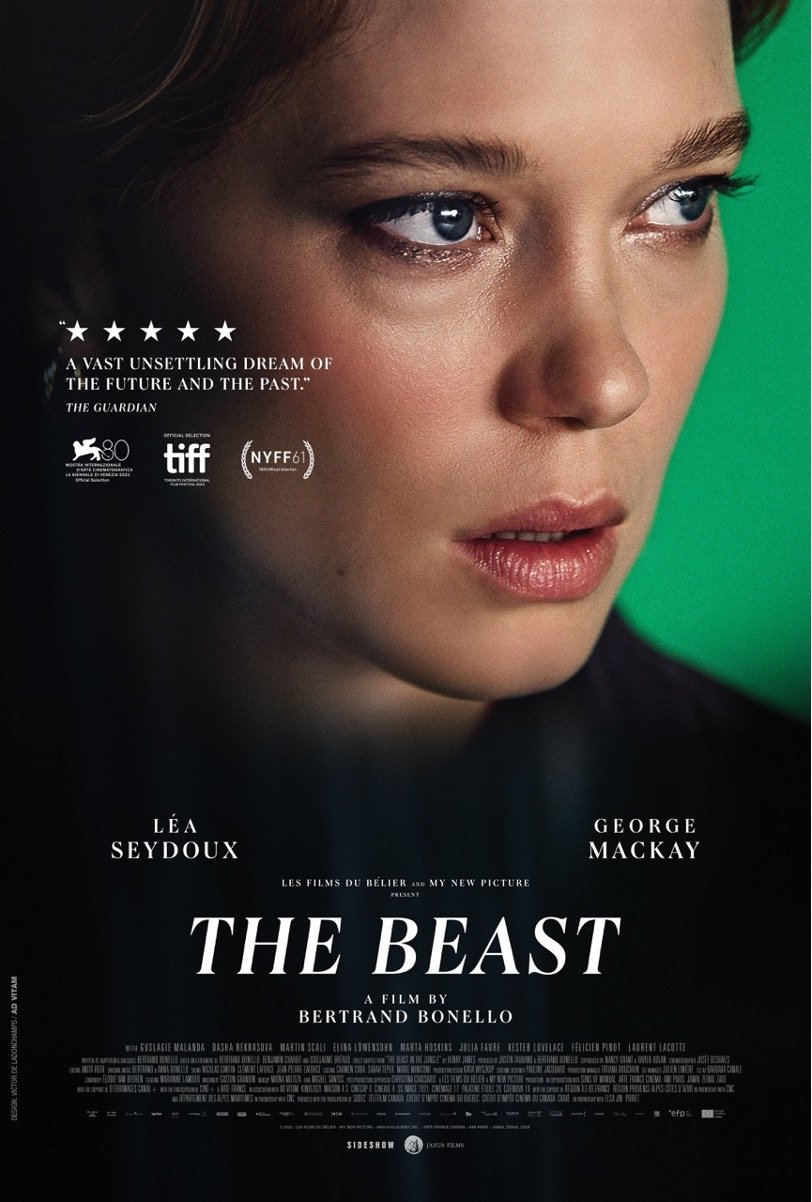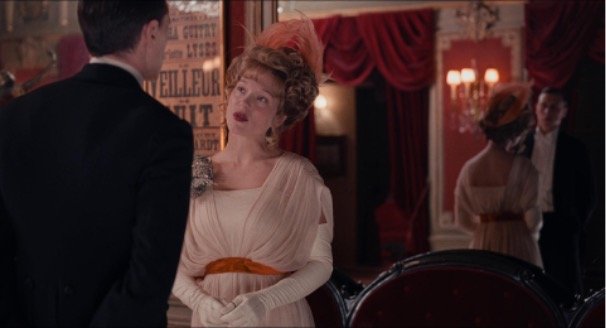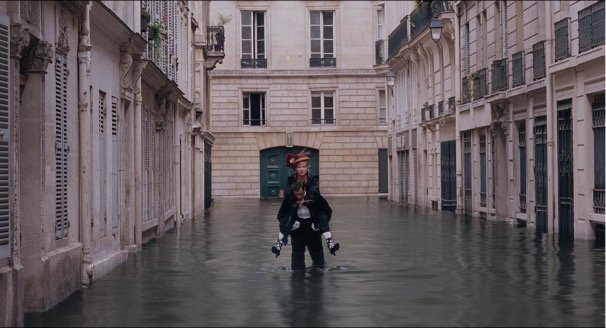
THE BEAST, A FUTURISTIC HENRY JAMES ADAPTATION
Cinema Writer/Film Critic Efe TEKSOY; wrote sci-fi, romance, drama film “THE BEAST”, for America’s Los Angeles-based Internet Newspaper @alaturkanews.

A POSTMODERN FILM
The Beast (La Bête), directed by French filmmaker Bertrand Bonello, is a loosely based adaptation of American author Henry James classic novel The Beast in the Jungle. The production stars the famous BAFTA-nominated French actress Léa Seydoux. It had its world premiere as part of official competition at the 80th Venice International Film Festival on September 3, 2023. The story of the film, interpreted in a modernized way with the science fiction genre, offers the audience a melodrama that covers three different periods (1910, 2014 and 2044). The film, in which we encounter a Futuristic and Postmodern narrative, also leaves us with Belle-époque Paris, where the Seine River overflowed during the Great Paris Flood of 1910 and flooded some parts of the city. However, under the theme of science fiction, we see that he touches upon philosophical issues such as “The Search for the Nature of Reality” and “The Problem of Existence”. Thus, we encounter a near future of the “Bio-Technological Brave New World” type that destroys the basic assumptions of our understanding of reality due to the techno-scientific progress of our age.

DARK FUTURE DESCRIPTION
This future, in which people are depicted as being taken over by artificial intelligence in the movie, is a dark future in which androids describe people as useless and unable to make decisions due to their emotions. This brings us to the disciplinary regime of the structuralist and postmodernist French philosopher Michel Foucault and the concept of biopolitics-biopower. South Korean philosopher and cultural theorist Byung-Chul Han, in his book Enfocracy: Digitalization and the Crisis of Democracy; “In the phenomenon of biopolitics, the target of disciplinary power is the body itself. Foucault apparently failed to notice its formation. The information regime is not based on any biopolitics. He is not interested in the body. It takes control of the psyche through psychopolitics.” he states, and states that the modern disciplinary regime is not a society of spectacle, but a society of surveillance. Thus, it seems that the dark future taken over by artificial intelligence in the movie is actually a society of surveillance and control.

TOPIC OF THE FILM
In a near future of 2044 where artificial intelligence has taken over most of the world’s jobs, humans are viewed by androids as useless and unable to make decisions due to their emotions. Some people go through the process of changing their DNA in order to find a better job, and through the Purification Process, they get rid of their strong emotions by entering their past lives. Gabrielle is a young woman who feels aimless in her job studying the warmth of data cores. He decides to purify his DNA so he can find a more satisfying job.
Stars; Léa Seydoux, George MacKay, Guslagie Malanda, Dasha Nekrasova, Martin Scali, Elina Löwensohn, Marta Hoskins, Julia Faure, Kester Lovelace and Felicien Pinot.

A TERRIFYING TIME TRAVEL
In this film, where we go on a metaphysical time journey where dreams and images are intertwined, we also go on a philosophical journey. We see that the past and the future are mixed together due to artificial intelligence taking over all control in the near future. The question that comes to mind is at what point in time the entity or absolute intelligence is located in this process. For this, we need to look at the history of thought. The famous German philosopher Friedrich Wilhelm Joseph von Schelling, who is known as a transition philosopher between Fichte and Hegel in the history of philosophy and one of the leading representatives of post-Kantian German Idealism, tried to combine the concept of nature he developed in his masterpiece “System of Transcendental Idealism” with Fichte’s philosophy, which takes the “I” as a starting point. and aimed to discover the basis of knowledge within a Kantian framework. Schelling says, “The question of whether the past-in-itself ever existed is as transcendental as the question of whether the thing-in-itself exists. The past exists only in the present, that is, it exists for everyone through everyone’s own original limitation; If this limitation is removed, everything that has happened would be the production of a single intelligence that has no beginning or end, like everything that is happening,” the philosopher states, adding that it should be said that absolute intelligence is everything that has happened and will happen.


ARCHITECTURAL SEMIOLOGY AND THE ARCHITECTURAL CODE
When the film’s setting is Paris, France, we cannot help but mention the architectural signs and geometric codes that stand out in the visual atmosphere. Italian philosopher, writer, medievalist and semiotician Umberto Eco, in his book Architectural Semiotics, introduces many innovations in the definition of functions, based on the conceptual structure of architectural signs being linked to functions. Eco says, “The architect examines whether the new technological elements introduced by the buildings he builds will force that primitive community to reconsider the traditional functions they used before.” Caught up in an avant-gardist impulse of destruction, the architect decides to force people to live in a completely different way. In the film, the artificial intelligence that virtually recreates reality (at the level of Jean Baudrillard’s Simulacra and Simulation) and takes the character Gabrielle on a journey through this reality, appears before us as an imaginary architect. However, this realistic dream universe he creates does not break realistic patterns and remains faithful to the architectural codes of Paris. Eco states that architecture has a tendency to transform rhetorical and ideological expectations and produce new knowledge, and in order for this tendency to be realized, architecture must preserve some of its existing codes. Italian architect Italo Gamberini proposes a “Code of Constitutive Indicators” for architecture. The patterns used for the interior in this proposal (such as indicators that determine the base, associative indicators and indicators that limit the exterior) are the essential patterns of architecture. Umberto Eco adds that “if such encryption is applied concretely (for many different structures), the possibilities it will offer will undoubtedly enable one to overcome the typological-rhetorical rigidity and frozenness of the previous code.” Also Eco; If architecture is the art of articulating spaces with each other, then the coding of this articulation could be as Euclid predicted in his geometry. At this point, he says that the elements of the first articulation will be place units – or chorems (place) – and the elements of the next articulation will be stoichea, that is, elements of classical geometry. Just like the artificial intelligence that created a completely realistic universe by preserving the existing architectural codes in the movie.
EFE TEKSOY
REFERENCES AND SOURCES
HAN. Byung-Chul, Enfocracy: Digitalization and the Crisis of Democracy (Enfokrasi: Dijitalleşme ve Demokrasinin Krizi), Mustafa Ozdemir, translate, Istanbul: Ketebe Yayinlari press, 2022
SCHELLING. Friedrich Wilhelm Joseph von, System of Transcendental Idealism, 1800 (Transandandal İdealizm Sistemi, 1800), Merve Ertene, translate, Ankara: Dogu Bati Yayinlari Press, 2022
ECO. Umberto, Semiotics of Architecture (Mimarlık Göstergebilimi), Fatma Erkman Akerson, translate, Daimon Yayinlari press, 2019





